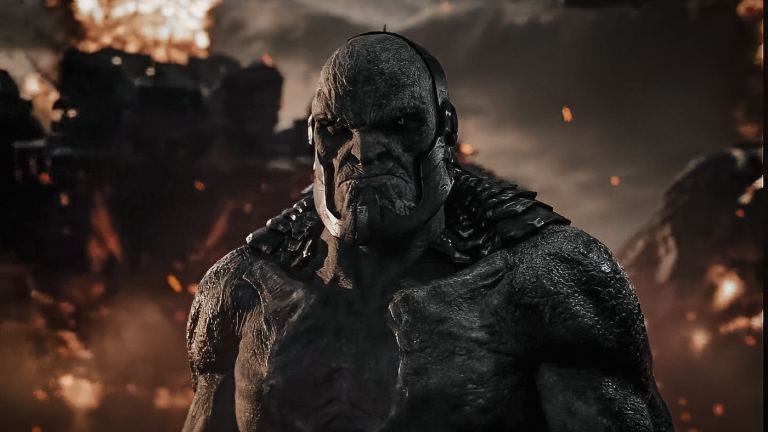Why Zack Snyder’s Justice League is in a 4:3 Aspect Ratio
We explore why Zack Snyder’s Justice League is the first major superhero movie to embrace a classic square frame with a 4:3 aspect ratio.

In the modern age of widescreen televisions and 4K ultra HD streaming, it likely took a few viewers by surprise. When you load up Zack Snyder’s Justice League on HBO Max, the streaming service offers the following notice: “This film is presented in a 4:3 format to preserve the integrity of Zack Snyder’s creative vision.”
In other words, no, you cannot adjust your TV or HBO Max account to make the black bars on the side of the image go away. Zack Snyder’s Justice League was filmed in a square frame, and that’s the way Snyder wants you now to see it. Amusingly, this makes the Snyder Cut the first major superhero movie to be presented in the “Academy Ratio” (or something close to it), which was the cinematic standard throughout most of the Golden Age of Hollywood, going into the 1950s. Snyder has spoken candidly a few times about the unlikely choice to shoot Justice League in a 1.33:1 aspect ratio with 35mm cameras. And as much else about the creative process on what became the Snyder Cut, this choice stemmed from reactions to Batman v Superman: Dawn of Justice.
Snyder, much like his colleague and friend Christopher Nolan, began experimenting on Batman v Superman by shooting select sequences in IMAX. True IMAX film cameras, which record the picture on 65mm celluloid, produce an aspect ratio of 1.43:1, which is much closer to a square (although not quite as much as what is used in ZSJL). And when BvS was screened in IMAX theaters in 2016, it meant the portions of the movie filmed in IMAX filled the entire IMAX screen. However, the majority of the film that was not shot in IMAX only covered the center of the IMAX screen, with a more traditional aspect ratio of 2.39:1.
The 2.39:1 aspect ratio is traditionally the preferred format for action blockbusters in the last 20 years, as it provides the widest common frame for films shot with 35mm cameras (and digital cameras mimicking them)—as opposed to say, using specially designed 70mm cameras which could go much wider. Yet upon seeing the alternating aspect ratios on BvS, Snyder came to the conclusion he’d like all of Justice League to have a uniformly square frame that could fill an entire IMAX screen. And rather than shoot a whole film in IMAX—which has never been done due to the technical imitations of bulky IMAX cameras—Snyder opted to shoot the film on 35mm with a 1.33:1 aspect ratio.
The effect is virtually indistinguishable from the Academy ratio of 1.37:1, which is the format used by any number of cinema classics like Citizen Kane, Casablanca, and The Adventures of Robin Hood (which, by the by, are all on HBO Max). However, prior to the Snyder Cut, the intent was always to present the film in a square frame in IMAX while cropping the upper and lower portions of the image for regular movie theaters (and presumably home media), creating a 1.78:1 aspect ratio, which is closer to another Hollywood standard for widescreen use. This is what “the Whedon Cut” ultimately did.
In 2020, Snyder explained at Justice Con his rationale for releasing the Snyder Cut in a 4:3 frame on HBO Max (the closest TV standard to 1.33:1) and foregoing the original plan to crop the image for widescreen televisions:
“My intent was to have the movie, the entire film, play in a gigantic 4:3 aspect ratio on a giant IMAX screen. Superheroes tend to be, as figures, they tend to be less horizontal. Maybe Superman when he’s flying, but when he’s standing, he’s more of a vertical. Everything is composed and shot that way, and a lot of the restoration is sort of trying to put that back. Put these big squares back… it’s a completely different aesthetic. It’s just got a different quality and one that is unusual. No one’s doing that.”
Indeed, playing with what are generally considered to be antiquated aspect ratios is usually the province of smaller arthouse and prestige pictures. For instance, Wes Anderson famously played with sliding aspect ratios in The Grand Budapest Hotel, with a different ratio for each of the three time periods the film is set in. More recently, Robert Eggers’ psychological horror thriller, The Lighthouse, resurrected the extreme rectangle frame of 1.19:1, where the vertical sides are subtly longer than the horizontal ones. This was an approach favored largely by German filmmakers in the silent era and early talkies (we talked to Eggers about the choice here). Kelly Reichardt’s First Cow, meanwhile, was shot in the Academy ratio of 1:37.1.
Snyder seems to welcome these comparisons, as he told The New York Times, “It’s in the same aspect ratio as First Cow. Those two movies share some common DNA, I think. [Laughs.] I really did like First Cow, actually. I would love that in a double feature, First Cow and the Snyder Cut of Justice League.”
Now with Zack Snyder’s Justice League streaming in a 4:3 aspect ratio, you can make that double feature happen at home!
